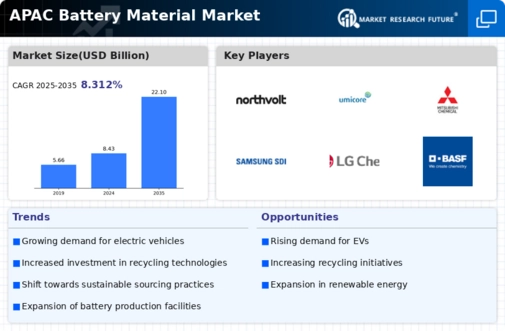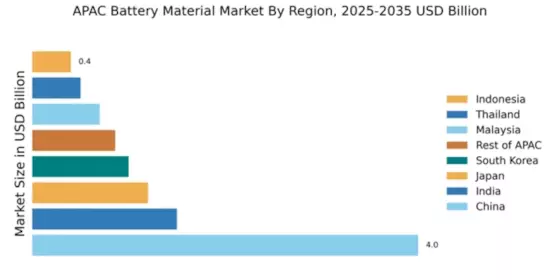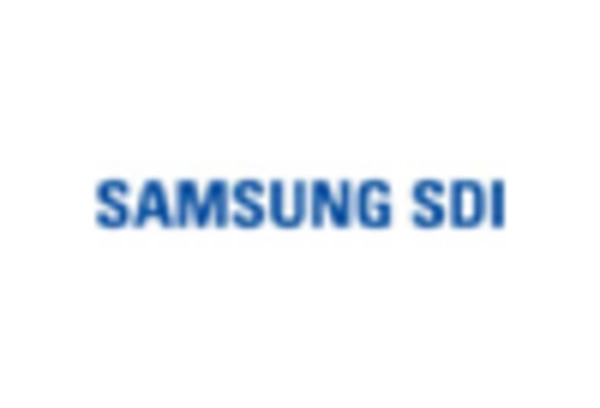Growth of Renewable Energy Sources
The expansion of renewable energy sources in APAC is a crucial driver for the battery material market. As countries invest in solar and wind energy, the need for efficient energy storage solutions becomes paramount. Battery systems are essential for balancing supply and demand, particularly in regions with high renewable penetration. The energy storage market is anticipated to grow at a CAGR of 25% through 2030, leading to increased demand for battery materials such as lithium and cobalt. This growth not only supports the transition to a low-carbon economy but also stimulates innovation in battery technologies, further enhancing the battery material market.
Government Regulations on Emissions
Stringent government regulations on emissions in APAC are significantly influencing the battery material market. Countries are implementing policies aimed at reducing carbon footprints, which in turn drives the transition to electric mobility and renewable energy solutions. For instance, the Chinese government has set ambitious targets to increase the share of EVs in the automotive market to 25% by 2030. Such regulations create a robust demand for battery materials, as manufacturers seek to comply with these standards. The battery material market is likely to benefit from increased investments in cleaner technologies and materials, fostering a more sustainable industry landscape.
Rising Demand for Electric Vehicles
The increasing adoption of electric vehicles (EVs) in APAC is a primary driver for the battery material market. As governments and consumers prioritize sustainability, the demand for EVs is projected to grow significantly. In 2025, the EV market in APAC is expected to account for approximately 40% of the total automotive market. This surge in EV production necessitates a corresponding increase in battery materials, particularly lithium, cobalt, and nickel. The battery material market is thus experiencing heightened activity as manufacturers strive to meet the growing demand for high-performance batteries. Furthermore, the shift towards EVs is likely to stimulate investments in battery recycling technologies, enhancing the sustainability of the battery material supply chain.
Increased Investment in Battery Recycling
The rising focus on sustainability is prompting increased investment in battery recycling within the battery material market in APAC. As the volume of used batteries grows, the need for efficient recycling processes becomes critical. Recycling can recover up to 95% of valuable materials like lithium, cobalt, and nickel, which are essential for new battery production. The market for battery recycling is projected to reach $5 billion by 2027, driven by both regulatory pressures and consumer demand for sustainable practices. This trend not only reduces the environmental impact of battery disposal but also creates a circular economy for battery materials, enhancing the overall sustainability of the industry.
Technological Innovations in Energy Storage
Technological advancements in energy storage solutions are reshaping the battery material market in APAC. Innovations such as solid-state batteries and advanced lithium-ion technologies are enhancing energy density and safety. The market for energy storage systems is projected to reach $20 billion by 2026, driven by the need for efficient energy management in renewable energy applications. These innovations not only improve battery performance but also create new opportunities for battery materials, including silicon anodes and advanced electrolytes. As manufacturers invest in research and development, the demand for high-quality battery materials is expected to rise, further propelling the growth of the battery material market.


















Leave a Comment